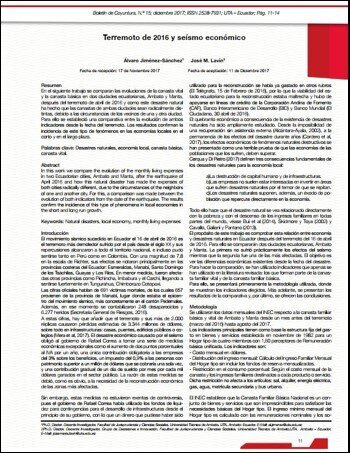2016 earthquake and economic seism
Main Article Content
Abstract
In this work we compare the evolution of the monthly living expenses in two Ecuadorian cities, Ambato and Manta, after the earthquake of April 2016 and how this natural disaster has made the expenses of both cities radically different, due to the circumstances of the neighbors of one and another city. For this, a comparison was made between the evolution of both indicators from the date of the earthquake. The results confirm the incidence of this type of phenomena in local economies in the short and long run growth.
DOI: https://doi.org/10.31164/bcoyu.15.2017.654
URL: http://revistas.uta.edu.ec/erevista/index.php/bcoyu/article/view/654
Downloads
Article Details

This work is licensed under a Creative Commons Attribution-NonCommercial 4.0 International License.
![]()
The publications of the Boletín de Coyuntura are licensed under a Creative Commons Attribution-NonCommercial 4.0 International License (CC BY-NC 4.0). The Universidad Técnica de Ambato retains the copyright of the published works, and favors and allows the reuse of these, as long as: the authorship and original source of publication is cited, and they are not used for commercial or onerous purposes. The intellectual property of the published articles belongs to the authors.
References
Alcántara-Ayala, I. (2002). Geomorphology, Natural Hazards, Vulnerability and Prevention of Natural Disasters in Developing Countries. Geomorphology, 47 (2-4), 107-124. Doi: https://doi.org/10.1016/S0169-555X(02)00083-1
Bui, A. T., Dungey. M., Nguyen, C. V. y Pham, T. P. (2014). The Impact of Natural Disasters on Household Income, Expenditure, Pover-ty and Inequality: Evidence from Vietnam. Applied Economics 46 (15), 1751–1766. Doi: 10.1080/00036846.2014.884706.
Cavallo, E., Galiani S., Noy, I. y Pantano, J. (2013). Catastrophic Natural Disasters and Economic Growth. Review of Economics and Statistics 95 (5), 1549–1561. Doi: 10.1162/REST_a_00413.
Cerqua, A. y Di Pietro, G. 2017. Natural disasters and univer-sity enrolment: evidence from L’Aquila earthquake, Applied Economics, 49(14), 1440-1457, Doi: 10.1080/00036846.2016.1218431
Ciudadano, el. (2016) Los fondos para la emergencia ya están atendiendo en las zonas afectadas por el terremoto. El Ciudadano. 30 de abril de 2016. Recuperado el 14 de noviembre de 2017: http://www.elciudadano.gob.ec/los-fondos-para-la-emergencia-ya-estan-atendien-do-en-las-zonas-afectadas-por-el-terremoto/
Cordero-Reyes, A. M., Palacios, I., Ramia, D., West, R., Valencia, M., Ramia, N., Egas, D., Rodas, P., Bahamonde, M. y Grunauer, M. 2017. Natural disaster management: experience of an academic institution after a 7.8 magnitude earthquake in Ecuador. Public Health 144, 134- 141. Doi: 10.1016/j.puhe.2016.12.003
Mera, W., Vera, X., La Tegola, A. y Ponce, G. 2017. April 2016 Ecuador Earthquake of Moment Magnitude Mw7.8: Overview and Damage Report. Key Engineering Materials 747, 662-669. Doi: 10.4028/www.scientific.net/KEM.747.662
Secretaría de Gestión de riesgos. 2016. Informe de situación N°71 – 19/05/2016 (20h30). Terremoto 7.8° - Pedernales.
Skidmore, M. y Toya H. 2002. ¿Do Natural Disasters Promote Longrun Growth? Economic Inquiry 40 (4), 664–687. Doi:10.1093/ei/40.4.664.
Telégrafo, El. (2016). Correa: “Los fonditos de liquidez (...) se hubieran pulverizado en 2 meses”. El Telégrafo. 15 de febrero de 2016. septiembre de 2016. Recuperado el 20 marzo septiembre de 2016. Recuperado el 14 de noviembre de 2017: http://www.eltelegrafo.com.ec/noticias/politica/2/correa-los-fonditos-de-liquidez-se-hubieran-pul-verizado-en-2-meses


